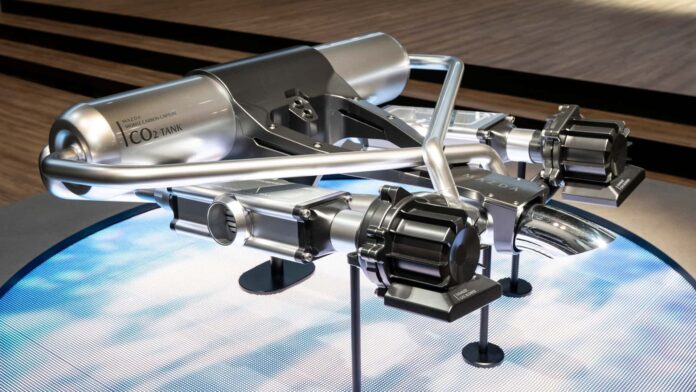It’s well known that Japanese automakers have long been reluctant to commit fully to battery electric vehicles. Toyota has been the most vocal about this stance, with chairman Akio Toyoda claiming EVs will never exceed a 30 percent market share. Instead, companies from the Land of the Rising Sun see biofuels as a potential savior of the internal combustion engine. Even hydrogen-burning ICEs might also play a role in decarbonization.
Mazda, though a much smaller company, shares a similar philosophy. It’s not ready to abandon combustion engines, believing they can still be made significantly cleaner. The Vision X-Coupe, unveiled at the Japan Mobility Show, made headlines for its sleek design and rotary engine, but there was more to it than that.
The swoopy show car was engineered to accommodate Mazda’s so-called “Mobile Carbon Capture” system, a device that literally sucks back up to 20 percent of the exhaust gases. While it may sound like Mazda is grasping at straws to save the combustion engine, the company insists it’s more than just a pipe dream.
‘While challenges remain, we’ve already established technology at the demonstration test level. We’re now moving into full-scale verification toward practical implementation. We have experimentally confirmed that CO₂ can be separated from exhaust gases using CO₂ adsorbents. We will begin demonstration testing of this CO₂ capture technology at the final round of this year’s Super Taikyu Series,’ said Kazuo Ichikawa, a specialist at Mazda’s Next-Generation Environmental Technology Research Department.
Ichikawa admits “there are still some issues to be resolved,” but the goal remains clear: to put the carbon-capture device into production cars. The captured exhaust gases are dried, and the carbon is bound to a crystalline zeolite substrate. The spent CO₂ stored in a small tank could then serve as a raw material, potentially for the production of recycled plastics.
The rotary engine we mentioned earlier doesn’t run on gasoline, but on plant-derived biofuel made from Nannochloropsis. It’s a type of microalgae with high lipid production efficiency, yielding oil with diesel-like properties. During its growth, the algae absorb CO₂ through photosynthesis.
Mazda believes that producing this microalgae-based fuel at a “relatively low cost” could cut CO₂ emissions by as much as 90 percent compared to fossil fuels. When combined with the carbon-capture system that recovers 20 percent of the car’s own emissions, Chief Technology Officer Ryuichi Umeshita says a vehicle like the Vision X-Coupe could achieve a net carbon-negative result of about 10 percent.
In theory, Mazda says, “the more you drive, the less CO₂ you emit.” But scaling up production of the biofuel remains a major challenge. It currently takes about two weeks to refine just over one liter of fuel from a 1,000-liter culture tank. Ideally, widespread biofuel production could make the carbon-negative scenario a reality.
The captured CO₂ could even be reused to grow more microalgae, meaning the car would help clean the air as it drives. Mazda is serious about making this vision a reality, but while the R&D makes sense, such a future depends heavily on scaling biofuel production to viable levels. There would also need to be an infrastructure in place to collect and properly dispose of or reuse the captured CO2.
Nevertheless, we should appreciate Mazda’s ongoing willingness to think outside the box. Only time will tell whether this latest approach leads to a dead end. Even if it does, the combustion engine isn’t going anywhere: the new Skyactiv-Z is coming.

